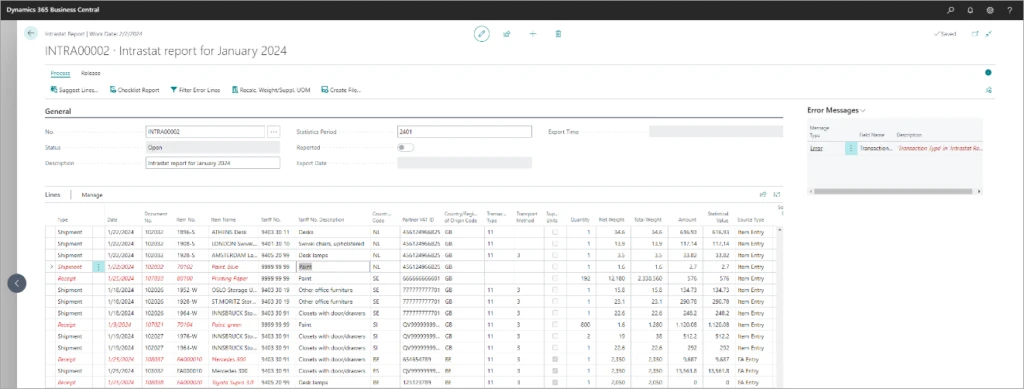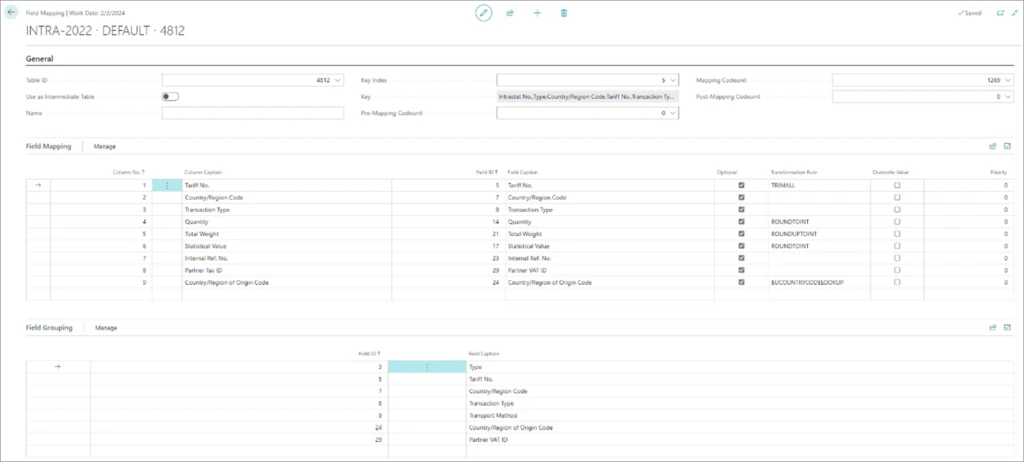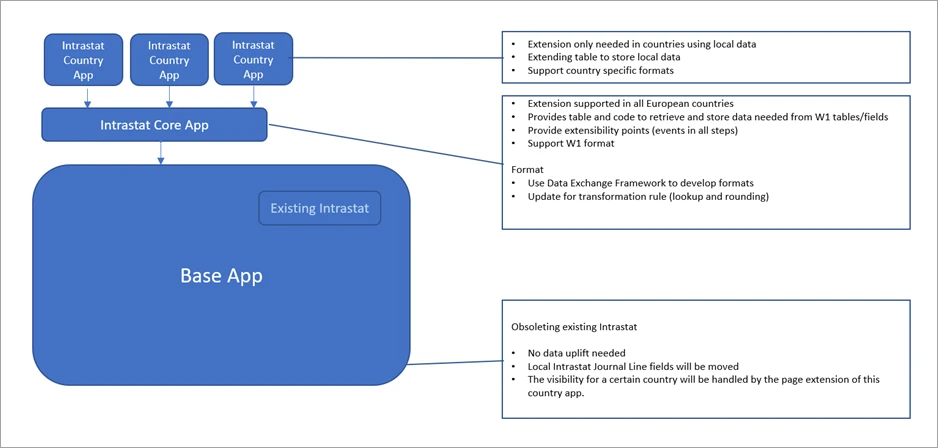This article is contributed. See the original author and article here.
Intrastat is the system the European Union (EU) uses to collect statistics on the trade in goods among EU member nations. Microsoft Dynamics 365 Business Central customers that operate in the EU can use the Intrastat Report to meet their monthly reporting requirements. With 2022 release wave 2 of Business Central, we’re introducing a redesigned Intrastat reporting experience with extended features. Here’s what you need to know.
Test in a sandbox first
The new experience is disabled by default. You’ll need to enable it on the Feature Management page in Business Central. We suggest you enable and test it in a sandbox environment with a copy of your production data first. Once you activate the new user experience in your production environment, you can’t go back to the old Intrastat functionality.
New Intrastat reporting experience
The old Intrastat Report was based on journals. In the new report, you’ll see a list of entries, and when you create a new Intrastat Report, it opens on the document page.

Additionally, Intrastat reporting is no longer part of the base application, but is now an extension.
Enhanced functionality
We’ve added features to make your Intrastat reporting smoother and more easily customized to meet your business needs.
- Data Exchange Framework for reporting. Almost all EU countries require a file for reporting. Previously we created a hardcoded file. Now we use the Data Exchange Framework, and you can easily create timestamped files for export. We include prepared formats for countries for which we have localizations. You can change the out-of-box report or make your own, especially if we don’t have a localization for your country.

- Configurable Checklist Report. After you fill in the Intrastat Report, you can run a configurable Checklist Report to make sure the information you entered is correct, and that all fields you indicated are mandatory have been entered.
- Fixed asset reporting. You can also include fixed assets in your report.
- Weight and supplementary unit management. For both goods and fixed assets, you can easily configure the weight and supplementary unit of measure and, if needed, recalculate weights and supplementary units without changing any other values.
- Manual corrections. You can manually correct your lines, and edited lines are indicated.
- More report configuration options. The new Intrastat Report configuration has more options, and you can also adjust your reporting in the Data Exchange Definition settings. You can set file export preferences, default values, which country will be the base for reporting, how to treat VAT numbers, and more.
- Service Declaration is coming soon as a separate app. Service Declaration, or Intrastat for Services, will be available in November 2022 as a separate app. Business Central will report services that come from the purchase and sale of items configured as services, resources, and item charges.
Technical information
- Now modularized and open source. With the new Intrastat application, the Business Central development team continues to apply the strategy of modularizing the common application layer (base application). At the same time, we’re providing more capabilities for partners to contribute by making both the Intrastat app and report formats open source.

- Developed for extensibility. The central part of the design is the Intrastat core app. The app allows a partner to define business in two ways:
- Use the app logic with the report format exposed through the Data Exchange Framework to generate the report
- For a heavily customized solution, define logic through the standard report configuration on the VAT Report Configuration page (suggest lines, content, response handler, and validation object)
To support extensibility, the app has 47 integration events. If you need to submit more than that, use the standard process.
- Customizable formats. After receiving many requests to allow easier report format modifications, we decided to expose the format through the Data Exchange Framework to support text and XML files. Microsoft will continue to provide changes in accordance with local market law requirements, but users may customize the format and keep their own version of the format definition. The Intrastat core application will have a common format defined in DataExchDefMap.xml in the AppResources folder.
- Country formats. The Intrastat core extension supports all countries and follows the existing Intrastat logic. For several countries, the required Intrastat format is significantly different. Microsoft is releasing country-specific apps, which will be developed on top of the Intrastat core app. Both Intrastat core and country apps will be preinstalled by default but must be enabled in Feature Management. Developers can choose to develop their solution on top of a common application layer, the Intrastat common application, or an Intrastat country app.
- Open-source app. Our goal is to open the source code completely, both the app code and report formats. The formats will be exposed as Data Exchange Framework schema and shared through GitHub. Like other first-party apps, the app code will be available on GitHub at ALAppExtensions/Apps/W1 at main microsoft/ALAppExtensions (github.com).
When will the new Intrastat reporting experience be available?
The new Intrastat experience is available starting in October 2022 with 2022 release wave 2 for all countries using the W1 version and country apps for Austria, Spain, and Sweden. Other country-based apps for Microsoft localizations only will be available in November 2022. Service Declaration will be available as an additional app in the same release starting in November.
For EU countries without Microsoft localization
What if you’re in an EU country where Microsoft doesn’t provide localization? In that case, partners can start by adding country-based features on top of the Intrastat core app as soon as the W1 version is available.
If you see some obstacles in this process, please contact us. Our intention was not to create a new Intrastat only for Microsoft localizations, but to create a solution that our partners can easily extend to meet local requirements.
Action needed
You should transition to the new Intrastat app soon. The existing Intrastat functionality will be supported until 2023 release wave 2 to provide enough time for a smooth transition. However, we encourage Business Central customers to move to the new Intrastat app before then.
Important notes:
- Existing Intrastat functionality is being deprecated. The Intrastat objects in the base application (27 in total) will be tagged for obsoletion and will be available until 2023 release wave 2.
- The transition process is one-directional. Once you move to the new Intrastat app, users will not be able to return to the old experience.
- No data will be transferred in the transition.
- There is no overlap between the existing and new Intrastat objects, so there is no risk of data corruption.
- Users who try to access existing Intrastat pages will be redirected to the new experience.
- To modify the assisted setup, use the following setting:
[EventSubscriber(ObjectType::Codeunit, Codeunit::"Feature Management Facade", 'OnAfterFeatureEnableConfirmed', '', true, true)]
Learn more
For more information about the new Intrastat reporting experience, read the documentation:
Work with Intrastat Reporting – Business Central | Microsoft Learn
Set Up Intrastat Reporting – Business Central | Microsoft Learn
Learn about more globalization features in Dynamics 365: Reduce complexity across global operations with Dynamics 365 – Microsoft Dynamics 365 Blog
New to Dynamics 365 Business Central? Try it for free.
The post Intrastat reporting redesigned in Dynamics 365 Business Central appeared first on Microsoft Dynamics 365 Blog.
Brought to you by Dr. Ware, Microsoft Office 365 Silver Partner, Charleston SC.


Recent Comments